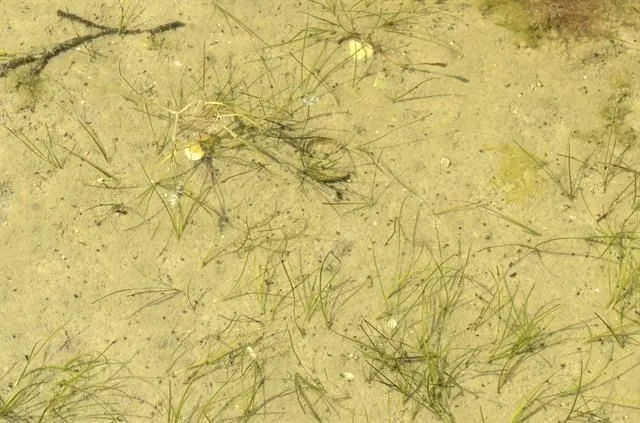
Author: (Petagna) Grande
Bibliography: Bull. Orto Bot. Regia Univ. Napoli 5: 58 (1918)
Year: 1918
Status: accepted
Rank: species
Genus: Ruppia
Vegetable: False
Observations: Temp. & Subtrop.
The Spiral Tasselweed, known scientifically as Ruppia cirrhosa, is an interesting and unique aquatic plant that belongs to the family Ruppiaceae. Described by the author (Petagna) Grande in the 1918 bulletin “Orto Botanico della Regia Università di Napoli,” this plant has fascinating biological and ecological characteristics that make it stand out.
Ruppia cirrhosa commonly thrives in temperate and subtropical regions. Its distinctive morphology, particularly the spiral structures of its reproductive organs (tassels), gives this plant its common name – Spiral Tasselweed. These spiraled tassels are not just visually striking but are also a specialized adaptation for its reproductive strategy in the aquatic environments where it grows.
Spiral Tasselweed typically inhabits both brackish and fresh water bodies. It is found in shallow waters where it can anchor itself securely in the sediment. The plant’s ability to grow in varying salinities allows it to colonize a range of aquatic ecosystems, from small inland ponds to expansive coastal marshlands.
Ecologically, Ruppia cirrhosa plays a crucial role in its habitat. It offers an important food source and habitat for various aquatic organisms. The dense mats formed by this plant provide shelter for small fish and invertebrates, protecting them from predators and harsh environmental conditions. Additionally, the plant contributes to the stabilization of sediment and helps in maintaining water clarity by trapping suspended particles.
While Ruppia cirrhosa is not often discussed in general botanical circles, it holds significant value for ecological and environmental studies. Its presence indicating the health of its aquatic ecosystem, researchers and conservationists monitor populations of Spiral Tasselweed to better understand and preserve the delicate balance of these water systems.
In conclusion, the Spiral Tasselweed (Ruppia cirrhosa) is more than just an aquatic plant with a unique spiral form. It is a species integral to the health and sustainability of many temperate and subtropical aquatic ecosystems, reflecting the intricate interactions within its environment that support biodiversity and ecological stability.
Dan: langstilket havgræs
Deu: spiralige ruppie, spiralsalde
Fra: ruppie spiralée, rupelle de trapani, rupelle spiralée, ruppie de trapani, ruppelle spiralée
Nor: sjøgras
Nld: spiraalruppia
Eng: spiral ditchgrass, spiral tasselweed, coiled pondweed, species code: rc, western ditchgrass, widgeongrass
Sme: smarbmeviđáš
Ita: erba da chiozzi spiralata, erba da chiozzi
Cym: tusau troellog, tusw troellog
En: Spiral tasselweed, Spiral ditchgrass, Spiral Ditch-Grass, Species code: Rc, Coiled Pondweed, Western ditchgrass, Widgeongrass
Da: Langstilket havgræs
Nl: Spiraalruppia
Et: Keerd-heinmuda
Fi: Kiertohapsikka
Fr: Rupelle de trapani, Rupelle spiralée, Ruppie de trapani, Ruppie spiralée, Ruppelle spiralée
De: Spiralsalde, Strand-Salde, Spiralige Ruppie, Spiral-Salde
He: רופיה לוליינית
Is: Vogajurt
It: Erba da chiozzi spiralata, Erba da chiozzi
Lt: Ilgakotė rupija
Se: Smarbmeviđáš
No: Skruehavgras, Sjøgras
Sv: Skruvnating
Uk: Рупія великовусикова
Cy: Tusw troellog, Tusau Troellog
Taken May 15, 2005 by Photoflora – Jean-Luc TASSET (©)
Taken Aug 3, 2022 by Cahit Doğan (cc-by-sa)
Taken Aug 3, 2018 by Jan Drnek (cc-by-sa)
Taken Jan 1, 1900 by EOL − Encyclopedia of Life (cc-by-nc)
Taken Sep 25, 2011 by Tela Botanica − Mathieu MENAND (cc-by-sa)
Taken Sep 25, 2011 by Tela Botanica − Mathieu MENAND (cc-by-sa)
Taken Jan 1, 1900 by EOL − Encyclopedia of Life (cc-by-nc)
Taken Jan 1, 1900 by EOL − Encyclopedia of Life (cc-by-nc)
Taken Aug 15, 2011 by Photoflora – Benoit BOCK (©)
Taken Aug 15, 2011 by Photoflora – Benoit BOCK (©)
Taken May 15, 2017 by Photoflora – Benoit BOCK (©)
Taken May 15, 2017 by Photoflora – Benoit BOCK (©)
Taken May 15, 2005 by Photoflora – Jean-Luc TASSET (©)
Taken May 15, 2005 by Photoflora – Jean-Luc TASSET (©)
Taken Aug 15, 2011 by Photoflora – Benoit BOCK (©)
Taken May 15, 2017 by Photoflora – Benoit BOCK (©)
Taken May 15, 2017 by Photoflora – Benoit BOCK (©)
Taken Jul 6, 2008 by Tela Botanica − Mathieu MENAND (cc-by-sa)
Taken Aug 15, 2011 by Photoflora – Benoit BOCK (©)
© copyright of the Board of Trustees of the Royal Botanic Gardens, Kew.
© copyright of the Board of Trustees of the Royal Botanic Gardens, Kew.
Growth form>: Rhizomatous
Growth habit>: Forb/herb
Growth rate>: Rapid
Ph maximum: 8.5
Ph minimum: 5.4
Light: 8
Atmospheric humidity: 9
Soil nutriments: 6
Soil salinity: 8
Family: Myrtaceae Author: (F.Muell.) K.D.Hill & L.A.S.Johnson Bibliography: Telopea 6: 402 (1995) Year: 1995 Status:…
Family: Rubiaceae Author: Pierre ex A.Froehner Bibliography: Notizbl. Bot. Gart. Berlin-Dahlem 1: 237 (1897) Year:…
Family: Sapindaceae Author: Koidz. Bibliography: J. Coll. Sci. Imp. Univ. Tokyo 32(1): 38 (1911) Year:…
Family: Asteraceae Author: A.Gray Bibliography: Pacif. Railr. Rep.: 107 (1857) Year: 1857 Status: accepted Rank:…
Family: Fabaceae Author: Medik. Bibliography: Vorles. Churpfälz. Phys.-Ökon. Ges. 2: 398 (1787) Year: 1787 Status:…
Family: Aspleniaceae Author: (Cav.) Alston Bibliography: Bull. Misc. Inform. Kew 1932: 309 (1932) Year: 1932…